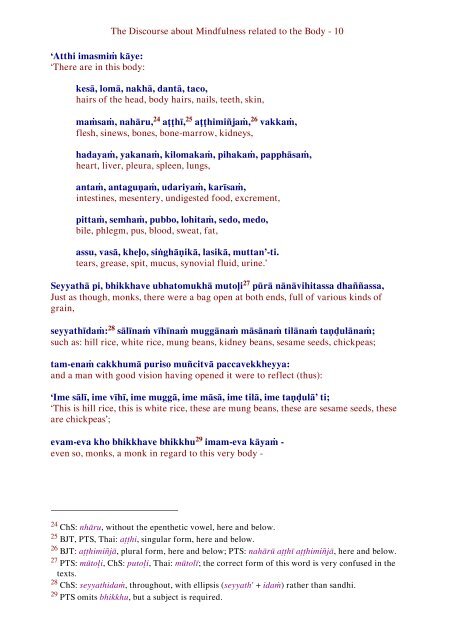Kayagatasatisuttam, the Discourse about Mindfulness related to the Body
A Pāli and English line by line (interlinear) version of this important discourse about the development of various meditations related to the body (together with extensive annotation).
A Pāli and English line by line (interlinear) version of this important discourse about the development of various meditations related to the body (together with extensive annotation).
Create successful ePaper yourself
Turn your PDF publications into a flip-book with our unique Google optimized e-Paper software.
‘Atthi imasmiṁ kāye:<br />
‘There are in this body:<br />
The <strong>Discourse</strong> <strong>about</strong> <strong>Mindfulness</strong> <strong>related</strong> <strong>to</strong> <strong>the</strong> <strong>Body</strong> - 10<br />
kesā, lomā, nakhā, dantā, taco,<br />
hairs of <strong>the</strong> head, body hairs, nails, teeth, skin,<br />
maṁsaṁ, nahāru, 24 aṭṭhī, 25 aṭṭhimiñjaṁ, 26 vakkaṁ,<br />
flesh, sinews, bones, bone-marrow, kidneys,<br />
hadayaṁ, yakanaṁ, kilomakaṁ, pihakaṁ, papphāsaṁ,<br />
heart, liver, pleura, spleen, lungs,<br />
antaṁ, antaguṇaṁ, udariyaṁ, karīsaṁ,<br />
intestines, mesentery, undigested food, excrement,<br />
pittaṁ, semhaṁ, pubbo, lohitaṁ, sedo, medo,<br />
bile, phlegm, pus, blood, sweat, fat,<br />
assu, vasā, kheḷo, siṅghāṇikā, lasikā, muttan’-ti.<br />
tears, grease, spit, mucus, synovial fluid, urine.’<br />
Seyyathā pi, bhikkhave ubha<strong>to</strong>mukhā mu<strong>to</strong>ḷi 27 pūrā nānāvihitassa dhaññassa,<br />
Just as though, monks, <strong>the</strong>re were a bag open at both ends, full of various kinds of<br />
grain,<br />
seyyathīdaṁ: 28 sālīnaṁ vīhīnaṁ muggānaṁ māsānaṁ tilānaṁ taṇḍulānaṁ;<br />
such as: hill rice, white rice, mung beans, kidney beans, sesame seeds, chickpeas;<br />
tam-enaṁ cakkhumā puriso muñcitvā paccavekkheyya:<br />
and a man with good vision having opened it were <strong>to</strong> reflect (thus):<br />
‘Ime sālī, ime vīhī, ime muggā, ime māsā, ime tilā, ime taṇḍulā’ ti;<br />
‘This is hill rice, this is white rice, <strong>the</strong>se are mung beans, <strong>the</strong>se are sesame seeds, <strong>the</strong>se<br />
are chickpeas’;<br />
evam-eva kho bhikkhave bhikkhu 29 imam-eva kāyaṁ -<br />
even so, monks, a monk in regard <strong>to</strong> this very body -<br />
24 ChS: nhāru, without <strong>the</strong> epen<strong>the</strong>tic vowel, here and below.<br />
25 BJT, PTS, Thai: aṭṭhi, singular form, here and below.<br />
26 BJT: aṭṭhimiñjā, plural form, here and below; PTS: nahārū aṭṭhī aṭṭhimiñjā, here and below.<br />
27 PTS: mū<strong>to</strong>ḷi, ChS: pu<strong>to</strong>ḷi, Thai: mū<strong>to</strong>lī; <strong>the</strong> correct form of this word is very confused in <strong>the</strong><br />
texts.<br />
28 ChS: seyyathidaṁ, throughout, with ellipsis (seyyath’ + idaṁ) ra<strong>the</strong>r than sandhi.<br />
29 PTS omits bhikkhu, but a subject is required.

















